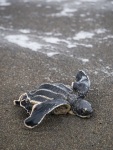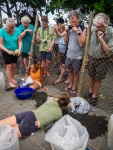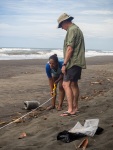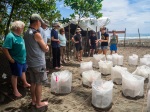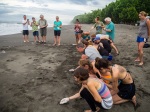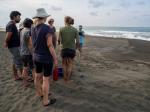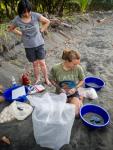One in a thousand
Leatherback turtles frequent much of the Caribbean coast of Costa Rica during the months of February and July to lay their eggs. One egg has a market value of $2 and one turtle can lay a clutch of up to 100 eggs. For poachers this is a significant income and poaching is rife on the Caribbean coast of Costa Rica. But without eggs hatching, the species will disappear. This is where Biosphere Expeditions and its partnership with LAST (Latin American Sea Turtles) comes in.
Our joint mission is to patrol the beach on a nightly basis and relocate as many clutches of eggs to a guarded hatchery as possible, thus preventing the poachers from taking all the eggs. For this a whole host of trained “foot soldiers” (Biosphere Expeditions team members) is need to monitor the beach, catch a turtle before she lays, wait as she digs her nest, then catch the falling eggs in a large plastic bag and whip them out from beneath her before she starts to fill in the nest and camouflage her tracks. Biometric data are also taken, and the nest re-dug by hand by the team member on duty in the hatchery. The nest, now safely in the hatchery, is guarded 24 hours a day for the next 60-70 days until the hatchlings emerge.
Magali Marion MSc is the lead scientist at Pacuare Research Centre. For the past three years she has worked tirelessly training volunteers, delivering lectures, leading night patrols, working with the local community and generally acting as the perfect role model for a successful conservation programme. “The key problem,” she says, “is that this is a public beach, so we have no control over who comes onto it.” The weekends are the worst with a noticeable increase of poachers lurking in the undergrowth. “Foot soldiers are really important,” says Magali, “as their number determines the amount of patrols we can run.”
“I’m amazed at myself and the energy this project unleashed in me!” says Janet Hoffberg a 76 year-old passionate animal advocate from Florida. The reward? To spot a turtle before the poachers and safely deposit the eggs in the hatchery. But, as Theresa Bowman, aged 43 from Germany, points out, “it’s not all black and white – we are used to the poachers being the ‘evil ones’, but there is more to it.”
This is a complicated issue and Magali has put herself right in the middle of it, working with the local association (La Asociacion para el Ambiente de Nuevo Pacuare) to offer poachers the chance to become guides for the project. There are ground rules – no alcohol or drug consumption, no more poaching, a willingness to learn and work with volunteers from around the globe. Some pass the test, some fail, but the beauty of Magali’s strategy is that whichever camp you fall into, there must be no confrontation between poachers and patrols. “Our mission is long-term. We will not eradicate poaching from Pacuare in the next year, but we believe that by providing alternative livelihoods to the community and involving children, we will change their mindset so they understand that natural resources must be exploited in a sustainable way. It involves long hours of talking and exchanging with different people without judging them. When we get to understand what is the social reason that pushes people to poach, then we can get to the root of the problem, which in Pacuare is geographical isolation, low education and poor job opportunity.”
As rainy season sets in a second threat to the turtle population is revealed – erosion. With constant storms raging out at sea, the high tides flood the beach, reducing the availability of viable leatherback nesting sites. Cyclical erosion has always occurred on this coastline, but with the added pressure of climate change, this erosion is becoming more extreme. “Nesting grounds are degraded by erosion”, says Magali, and this year’s El Nino event has been very intense, which is now leading to an equally intense rainy season. We have reinforced the hatchery, so that it will not be eroded by the waves, but if the water table gets too high, the nests can be flooded from below.”
So what does the expedition mean in conservation terms? 15 clutches of eggs safely relocated to the hatchery; clutches, which if left in their natural condition would have either been poached or washed out to sea. This amounts to over 1000 potential hatchlings, and based on statistical probability, that is one adult who against all the odds will return in 15 years to lay her own clutch. This may not sound like much, but for a dwindling population of fewer than 4,000 leatherback turtles on the Caribbean coast, every single one counts.
Costa Rica 2016 pictures and videos





